Attractions · Bosnia and Herzegovina · Bulgaria · Croatia · Eastern Europe · Estonia · Europe · Going Out · Hungary · Russia
Travel inspiration: 8 of Eastern Europe’s best UNESCO sites
Europe is a culmination of fascinating cities, ancient architecture and beautiful landscapes, so no matter what you’re after there will be something that blows you away. Naturally, such rich history and raw beauty is bound to produce some sites that are culturally valuable and thus have landed on the UNESCO world heritage list. Below are eight of our favourite sites that you can find in Eastern Europe.
Plitvice National Park, Croatia
The cascading waterfalls of Plitvice Lakes were added to the natural UNESCO list in 1979. The stunning location is one of Croatia’s largest and oldest national parks, extending over 73,000 acres. The reserve encompasses various lakes, waterfalls, cliffs and walkways, and due to the natural growth of algae and minerals in the water, create beautiful shades of greens and turquoise that shimmer in the summer sun. The man-made wooden walkways allow visitors to enjoy some of the best views in the park, with multiple paths and areas to choose from. For the best experience, pick one of the local hotels situated inside the park so that you can awake nice and early and enter through the gates as they open – beating the crowds.
 Mostar Old Town & Bridge, Bosnia & Herzegovina
Widely considered the prettiest town in Bosnia and Herzegovina, Mostar oozes old world charm and has a whole host of stunning sites for travellers. The Old Town and Stari Most (Old Bridge) are UNESCO listed because of their excellent representation of Islamic architecture in the Balkans – dating back to around the 16th century. Wander through the old bazaar, where you’ll find a fantastic assortment of handmade crafts and quirky gifts, or pop into one of the cosy restaurants along the bank of the river and dine on a local dish while enjoying unrivalled views of the bridge.
Mostar Old Town & Bridge, Bosnia & Herzegovina
Widely considered the prettiest town in Bosnia and Herzegovina, Mostar oozes old world charm and has a whole host of stunning sites for travellers. The Old Town and Stari Most (Old Bridge) are UNESCO listed because of their excellent representation of Islamic architecture in the Balkans – dating back to around the 16th century. Wander through the old bazaar, where you’ll find a fantastic assortment of handmade crafts and quirky gifts, or pop into one of the cosy restaurants along the bank of the river and dine on a local dish while enjoying unrivalled views of the bridge.
 Rila Monastery, Bulgaria
Rila Monastery is the largest Eastern Orthodox monastery in Bulgaria. Founded in the 10th century, the building is considered one of the most important historical and culture sites in the country. Established in 927 AD, the complex occupies just short of 9000 m2 and contains the main church, a courtyard, a museum and the old residential section with 300 chambers, four chapels and a library which contains 250 manuscripts. The complex was declared a national historical monument in 1976 and 7 years later was added to the UNESCO world heritage list. The spiritual centre continually stuns visitors with the colourful frescoes, detailed arches and fascinating religious art. Why not combine a trip to Rila Monastery with some walking in Rila National Park? The largest national park in Bulgaria offers sweeping views of the mountain landscape as well as the beautiful seven lakes.
Rila Monastery, Bulgaria
Rila Monastery is the largest Eastern Orthodox monastery in Bulgaria. Founded in the 10th century, the building is considered one of the most important historical and culture sites in the country. Established in 927 AD, the complex occupies just short of 9000 m2 and contains the main church, a courtyard, a museum and the old residential section with 300 chambers, four chapels and a library which contains 250 manuscripts. The complex was declared a national historical monument in 1976 and 7 years later was added to the UNESCO world heritage list. The spiritual centre continually stuns visitors with the colourful frescoes, detailed arches and fascinating religious art. Why not combine a trip to Rila Monastery with some walking in Rila National Park? The largest national park in Bulgaria offers sweeping views of the mountain landscape as well as the beautiful seven lakes.
 Dubrovnik Old Town, Croatia
Another of Croatia’s most popular destinations, the historic town of Dubrovnik nestled within the grand city walls is a sea of charming houses, dusty orange and red rooftops and churches steeped in history. Dating back to the 7th century, Dubrovnik was an important port throughout the centuries due to its strategic location and the charming old quarter is a raw reminder of times gone by – just strolling through the medieval streets will bring you back to another world. The best way to experience the old town is by walking the city walls as early as possible, ideally at opening time when there are far less crowds. Enjoy a peaceful walk with beautiful sea views on one side and terracotta rooftops on the other, taking in the beauty that Dubrovnik has to offer.
Dubrovnik Old Town, Croatia
Another of Croatia’s most popular destinations, the historic town of Dubrovnik nestled within the grand city walls is a sea of charming houses, dusty orange and red rooftops and churches steeped in history. Dating back to the 7th century, Dubrovnik was an important port throughout the centuries due to its strategic location and the charming old quarter is a raw reminder of times gone by – just strolling through the medieval streets will bring you back to another world. The best way to experience the old town is by walking the city walls as early as possible, ideally at opening time when there are far less crowds. Enjoy a peaceful walk with beautiful sea views on one side and terracotta rooftops on the other, taking in the beauty that Dubrovnik has to offer.
 Moscow Red Square, Russia
Moscow Red Square, its name derived from the old Russian word krasniy meaning beautiful, is characterised by the stunning architecture that surrounds it – especially the colourful and vibrant St Basil’s Cathedral. It remains one of the most important squares in the city and is often the location of celebrations, demonstrations and historical events. Visit the Red Square and you’ll find a variety of important buildings which are worth a visit. First off is the beautiful State Historical Museum, which showcases an assortment of exhibitions from prehistoric tribes to modern day Russia. The GUM, which functioned as a state department store during the Soviet era, now operates as a shopping mall – but the stunning facade with its archways and detailing is well worth stopping by. The Kremlin, the official residence of the president, can be seen towering over the southern section of the square, next to St Basil’s Cathedral, which is possibly the most famous image of Moscow. Finally, Lenin’s Mausoleum, the resting place of Soviet leader Vladamir Lenin, is situated in the Red Square, drawing in tourists interested in learning more about Russia’s history. Between the history of the Red Square and its fascinating buildings tied to Russia, it was added to the UNESCO heritage site list in 1990 and remains the most popular tourist attraction in Moscow.
Moscow Red Square, Russia
Moscow Red Square, its name derived from the old Russian word krasniy meaning beautiful, is characterised by the stunning architecture that surrounds it – especially the colourful and vibrant St Basil’s Cathedral. It remains one of the most important squares in the city and is often the location of celebrations, demonstrations and historical events. Visit the Red Square and you’ll find a variety of important buildings which are worth a visit. First off is the beautiful State Historical Museum, which showcases an assortment of exhibitions from prehistoric tribes to modern day Russia. The GUM, which functioned as a state department store during the Soviet era, now operates as a shopping mall – but the stunning facade with its archways and detailing is well worth stopping by. The Kremlin, the official residence of the president, can be seen towering over the southern section of the square, next to St Basil’s Cathedral, which is possibly the most famous image of Moscow. Finally, Lenin’s Mausoleum, the resting place of Soviet leader Vladamir Lenin, is situated in the Red Square, drawing in tourists interested in learning more about Russia’s history. Between the history of the Red Square and its fascinating buildings tied to Russia, it was added to the UNESCO heritage site list in 1990 and remains the most popular tourist attraction in Moscow.
 Budapest Central Area, Hungary
Budapest is a captivating city where a rich history is intertwined with an ever changing modern day culture. Divided by the Danube River, the northern section of the city, Pest, is bursting with cool bars and restaurants, rows of shopping streets and popular attractions such as the Szechenyi Thermal Baths and Budapest Parliament. Across the river you’ll find Buda, a hilly and quieter part of town that is home to Budapest’s old quarter, the Buda Castle and ancient structures such as the Fisherman’s Bastion. Both of these areas combined create a city with an abundance of fascinating sights, lovely viewpoints of some of the cities most prominent structures and an atmosphere so enjoyable that Budapest has quickly become the go-to Eastern European destination. It’s the central area surrounding the Danube River that is now UNESCO listed, due to the prominence of the city’s historical buildings – the Parliament and the Buda Castle. Andrassy Avenue was added to the UNESCO list in 2002 – a street famous for its beautiful neo-renaissance buildings which date back to 1872. It’s now one of the most famous shopping streets in Budapest and is worth a stroll for both the architecture, shops and cafe experience.
Budapest Central Area, Hungary
Budapest is a captivating city where a rich history is intertwined with an ever changing modern day culture. Divided by the Danube River, the northern section of the city, Pest, is bursting with cool bars and restaurants, rows of shopping streets and popular attractions such as the Szechenyi Thermal Baths and Budapest Parliament. Across the river you’ll find Buda, a hilly and quieter part of town that is home to Budapest’s old quarter, the Buda Castle and ancient structures such as the Fisherman’s Bastion. Both of these areas combined create a city with an abundance of fascinating sights, lovely viewpoints of some of the cities most prominent structures and an atmosphere so enjoyable that Budapest has quickly become the go-to Eastern European destination. It’s the central area surrounding the Danube River that is now UNESCO listed, due to the prominence of the city’s historical buildings – the Parliament and the Buda Castle. Andrassy Avenue was added to the UNESCO list in 2002 – a street famous for its beautiful neo-renaissance buildings which date back to 1872. It’s now one of the most famous shopping streets in Budapest and is worth a stroll for both the architecture, shops and cafe experience.
 Tallinn Historic Centre, Estonia
The capital of Estonia, Tallinn lies on the coast of the Gulf of Finland and is one of the most popular cities in the Baltic’s. The fairy-tale city quickly transports you to another time, with its charming medieval streets and string of old-age buildings – in fact the city is home to one of the most well preserved Old Towns in Eastern Europe. Since making the list of UNESCO world heritage sites in 1997, Tallinn has flourished into a destination which offers a rich history and modern day flare. The area of the Old Quarter dates back to the 13th century with the majority of the buildings being erected between then and the 16th century. Contained within the ancient city walls is Toompea Hill, St. Olav’s Church and Alexander Nevsky Cathedral. Explore the main square where you’ll find traditional restaurants serving hearty Estonian stews and meats (and local beer!) or wonder up Toompea Hill for the best views over the terracotta rooftops below. Tick off a trip to the Baltic’s by also visiting Riga and Vilnius (capitals of Latvia and Lithuania) which are reached in only a few hours. Both Riga and Vilnius also have UNESCO listed Old Town’s making them fantastic additions for a holiday that dives into the rich history of this corner of the world.
Tallinn Historic Centre, Estonia
The capital of Estonia, Tallinn lies on the coast of the Gulf of Finland and is one of the most popular cities in the Baltic’s. The fairy-tale city quickly transports you to another time, with its charming medieval streets and string of old-age buildings – in fact the city is home to one of the most well preserved Old Towns in Eastern Europe. Since making the list of UNESCO world heritage sites in 1997, Tallinn has flourished into a destination which offers a rich history and modern day flare. The area of the Old Quarter dates back to the 13th century with the majority of the buildings being erected between then and the 16th century. Contained within the ancient city walls is Toompea Hill, St. Olav’s Church and Alexander Nevsky Cathedral. Explore the main square where you’ll find traditional restaurants serving hearty Estonian stews and meats (and local beer!) or wonder up Toompea Hill for the best views over the terracotta rooftops below. Tick off a trip to the Baltic’s by also visiting Riga and Vilnius (capitals of Latvia and Lithuania) which are reached in only a few hours. Both Riga and Vilnius also have UNESCO listed Old Town’s making them fantastic additions for a holiday that dives into the rich history of this corner of the world.
 Wooden churches of Maramures, Romania
Widely considered masterpieces of ancient Romanian architecture, these eight wooden churches are situated in the region of Maramures. Maramures, also known as Land of the Wood, is nestled in the very north of Romania. Bursting with tradition and peppered with relics of the country’s rich history, the small area of Maramures is a must see for anyone visiting Romania. Dating back to the 17th century, the wooden churches of Maramures were included in UNESCO’s world heritage list in 1999 because of their traditional timber construction and representation of traditional architecture in the region. Visiting these churches will give you a deeper understanding of where the name The Land of the Wood is derived from, most of the construction was done using wood including nails. The interiors of the churches are just as impressive, with paintings and murals depicting religious events and everyday beliefs.
Wooden churches of Maramures, Romania
Widely considered masterpieces of ancient Romanian architecture, these eight wooden churches are situated in the region of Maramures. Maramures, also known as Land of the Wood, is nestled in the very north of Romania. Bursting with tradition and peppered with relics of the country’s rich history, the small area of Maramures is a must see for anyone visiting Romania. Dating back to the 17th century, the wooden churches of Maramures were included in UNESCO’s world heritage list in 1999 because of their traditional timber construction and representation of traditional architecture in the region. Visiting these churches will give you a deeper understanding of where the name The Land of the Wood is derived from, most of the construction was done using wood including nails. The interiors of the churches are just as impressive, with paintings and murals depicting religious events and everyday beliefs.
 Matt Gannan is the CEO and Owner of Tucan Travel. Tucan Travel operate cultural tours in Latin America, Africa and the Middle East, Asia and Europe, as well as tailor-made holidays in Latin America, Africa and Asia.
If you would like to be a guest blogger on A Luxury Travel Blog in order to raise your profile, please contact us.
Matt Gannan is the CEO and Owner of Tucan Travel. Tucan Travel operate cultural tours in Latin America, Africa and the Middle East, Asia and Europe, as well as tailor-made holidays in Latin America, Africa and Asia.
If you would like to be a guest blogger on A Luxury Travel Blog in order to raise your profile, please contact us.
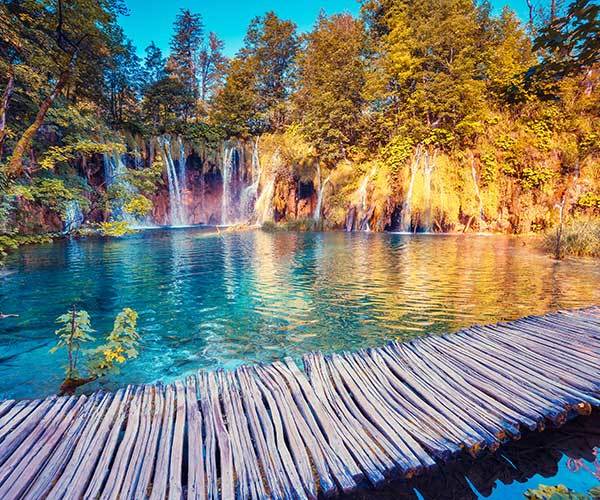 Mostar Old Town & Bridge, Bosnia & Herzegovina
Widely considered the prettiest town in Bosnia and Herzegovina, Mostar oozes old world charm and has a whole host of stunning sites for travellers. The Old Town and Stari Most (Old Bridge) are UNESCO listed because of their excellent representation of Islamic architecture in the Balkans – dating back to around the 16th century. Wander through the old bazaar, where you’ll find a fantastic assortment of handmade crafts and quirky gifts, or pop into one of the cosy restaurants along the bank of the river and dine on a local dish while enjoying unrivalled views of the bridge.
Mostar Old Town & Bridge, Bosnia & Herzegovina
Widely considered the prettiest town in Bosnia and Herzegovina, Mostar oozes old world charm and has a whole host of stunning sites for travellers. The Old Town and Stari Most (Old Bridge) are UNESCO listed because of their excellent representation of Islamic architecture in the Balkans – dating back to around the 16th century. Wander through the old bazaar, where you’ll find a fantastic assortment of handmade crafts and quirky gifts, or pop into one of the cosy restaurants along the bank of the river and dine on a local dish while enjoying unrivalled views of the bridge.
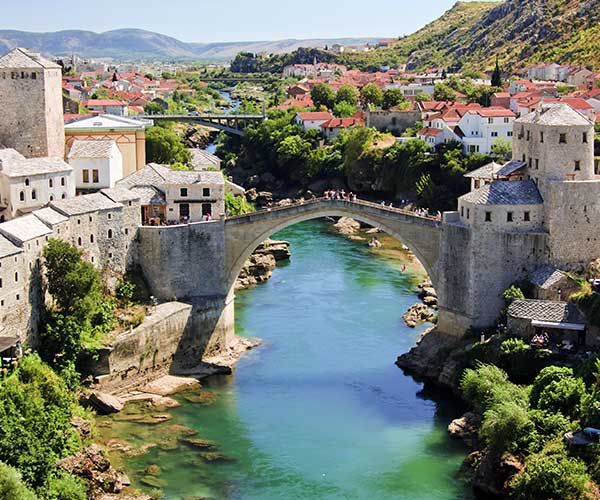 Rila Monastery, Bulgaria
Rila Monastery is the largest Eastern Orthodox monastery in Bulgaria. Founded in the 10th century, the building is considered one of the most important historical and culture sites in the country. Established in 927 AD, the complex occupies just short of 9000 m2 and contains the main church, a courtyard, a museum and the old residential section with 300 chambers, four chapels and a library which contains 250 manuscripts. The complex was declared a national historical monument in 1976 and 7 years later was added to the UNESCO world heritage list. The spiritual centre continually stuns visitors with the colourful frescoes, detailed arches and fascinating religious art. Why not combine a trip to Rila Monastery with some walking in Rila National Park? The largest national park in Bulgaria offers sweeping views of the mountain landscape as well as the beautiful seven lakes.
Rila Monastery, Bulgaria
Rila Monastery is the largest Eastern Orthodox monastery in Bulgaria. Founded in the 10th century, the building is considered one of the most important historical and culture sites in the country. Established in 927 AD, the complex occupies just short of 9000 m2 and contains the main church, a courtyard, a museum and the old residential section with 300 chambers, four chapels and a library which contains 250 manuscripts. The complex was declared a national historical monument in 1976 and 7 years later was added to the UNESCO world heritage list. The spiritual centre continually stuns visitors with the colourful frescoes, detailed arches and fascinating religious art. Why not combine a trip to Rila Monastery with some walking in Rila National Park? The largest national park in Bulgaria offers sweeping views of the mountain landscape as well as the beautiful seven lakes.
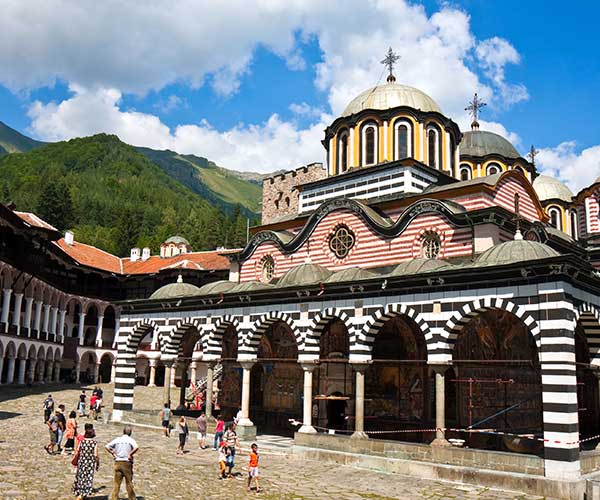 Dubrovnik Old Town, Croatia
Another of Croatia’s most popular destinations, the historic town of Dubrovnik nestled within the grand city walls is a sea of charming houses, dusty orange and red rooftops and churches steeped in history. Dating back to the 7th century, Dubrovnik was an important port throughout the centuries due to its strategic location and the charming old quarter is a raw reminder of times gone by – just strolling through the medieval streets will bring you back to another world. The best way to experience the old town is by walking the city walls as early as possible, ideally at opening time when there are far less crowds. Enjoy a peaceful walk with beautiful sea views on one side and terracotta rooftops on the other, taking in the beauty that Dubrovnik has to offer.
Dubrovnik Old Town, Croatia
Another of Croatia’s most popular destinations, the historic town of Dubrovnik nestled within the grand city walls is a sea of charming houses, dusty orange and red rooftops and churches steeped in history. Dating back to the 7th century, Dubrovnik was an important port throughout the centuries due to its strategic location and the charming old quarter is a raw reminder of times gone by – just strolling through the medieval streets will bring you back to another world. The best way to experience the old town is by walking the city walls as early as possible, ideally at opening time when there are far less crowds. Enjoy a peaceful walk with beautiful sea views on one side and terracotta rooftops on the other, taking in the beauty that Dubrovnik has to offer.
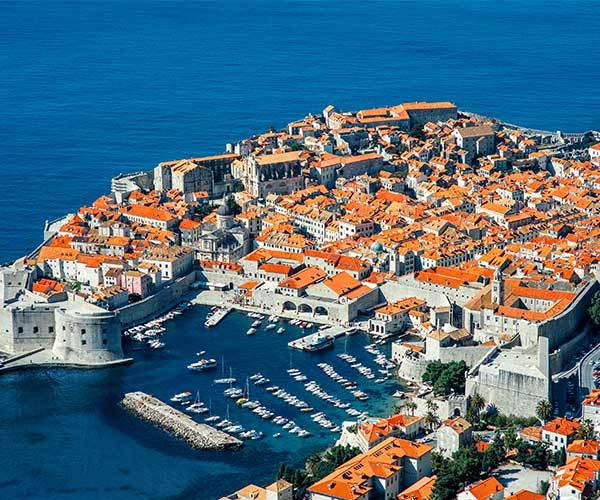 Moscow Red Square, Russia
Moscow Red Square, its name derived from the old Russian word krasniy meaning beautiful, is characterised by the stunning architecture that surrounds it – especially the colourful and vibrant St Basil’s Cathedral. It remains one of the most important squares in the city and is often the location of celebrations, demonstrations and historical events. Visit the Red Square and you’ll find a variety of important buildings which are worth a visit. First off is the beautiful State Historical Museum, which showcases an assortment of exhibitions from prehistoric tribes to modern day Russia. The GUM, which functioned as a state department store during the Soviet era, now operates as a shopping mall – but the stunning facade with its archways and detailing is well worth stopping by. The Kremlin, the official residence of the president, can be seen towering over the southern section of the square, next to St Basil’s Cathedral, which is possibly the most famous image of Moscow. Finally, Lenin’s Mausoleum, the resting place of Soviet leader Vladamir Lenin, is situated in the Red Square, drawing in tourists interested in learning more about Russia’s history. Between the history of the Red Square and its fascinating buildings tied to Russia, it was added to the UNESCO heritage site list in 1990 and remains the most popular tourist attraction in Moscow.
Moscow Red Square, Russia
Moscow Red Square, its name derived from the old Russian word krasniy meaning beautiful, is characterised by the stunning architecture that surrounds it – especially the colourful and vibrant St Basil’s Cathedral. It remains one of the most important squares in the city and is often the location of celebrations, demonstrations and historical events. Visit the Red Square and you’ll find a variety of important buildings which are worth a visit. First off is the beautiful State Historical Museum, which showcases an assortment of exhibitions from prehistoric tribes to modern day Russia. The GUM, which functioned as a state department store during the Soviet era, now operates as a shopping mall – but the stunning facade with its archways and detailing is well worth stopping by. The Kremlin, the official residence of the president, can be seen towering over the southern section of the square, next to St Basil’s Cathedral, which is possibly the most famous image of Moscow. Finally, Lenin’s Mausoleum, the resting place of Soviet leader Vladamir Lenin, is situated in the Red Square, drawing in tourists interested in learning more about Russia’s history. Between the history of the Red Square and its fascinating buildings tied to Russia, it was added to the UNESCO heritage site list in 1990 and remains the most popular tourist attraction in Moscow.
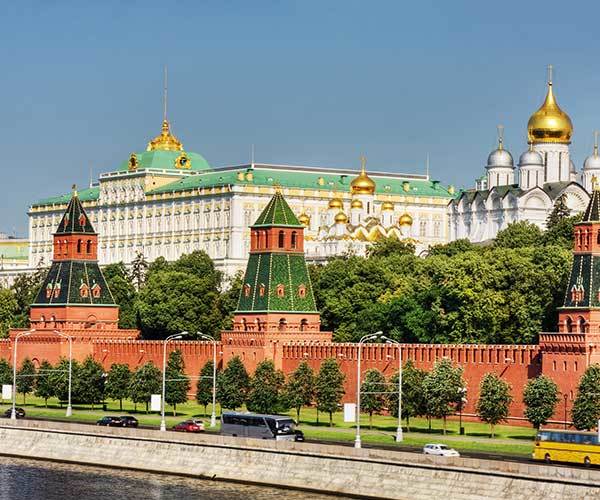 Budapest Central Area, Hungary
Budapest is a captivating city where a rich history is intertwined with an ever changing modern day culture. Divided by the Danube River, the northern section of the city, Pest, is bursting with cool bars and restaurants, rows of shopping streets and popular attractions such as the Szechenyi Thermal Baths and Budapest Parliament. Across the river you’ll find Buda, a hilly and quieter part of town that is home to Budapest’s old quarter, the Buda Castle and ancient structures such as the Fisherman’s Bastion. Both of these areas combined create a city with an abundance of fascinating sights, lovely viewpoints of some of the cities most prominent structures and an atmosphere so enjoyable that Budapest has quickly become the go-to Eastern European destination. It’s the central area surrounding the Danube River that is now UNESCO listed, due to the prominence of the city’s historical buildings – the Parliament and the Buda Castle. Andrassy Avenue was added to the UNESCO list in 2002 – a street famous for its beautiful neo-renaissance buildings which date back to 1872. It’s now one of the most famous shopping streets in Budapest and is worth a stroll for both the architecture, shops and cafe experience.
Budapest Central Area, Hungary
Budapest is a captivating city where a rich history is intertwined with an ever changing modern day culture. Divided by the Danube River, the northern section of the city, Pest, is bursting with cool bars and restaurants, rows of shopping streets and popular attractions such as the Szechenyi Thermal Baths and Budapest Parliament. Across the river you’ll find Buda, a hilly and quieter part of town that is home to Budapest’s old quarter, the Buda Castle and ancient structures such as the Fisherman’s Bastion. Both of these areas combined create a city with an abundance of fascinating sights, lovely viewpoints of some of the cities most prominent structures and an atmosphere so enjoyable that Budapest has quickly become the go-to Eastern European destination. It’s the central area surrounding the Danube River that is now UNESCO listed, due to the prominence of the city’s historical buildings – the Parliament and the Buda Castle. Andrassy Avenue was added to the UNESCO list in 2002 – a street famous for its beautiful neo-renaissance buildings which date back to 1872. It’s now one of the most famous shopping streets in Budapest and is worth a stroll for both the architecture, shops and cafe experience.
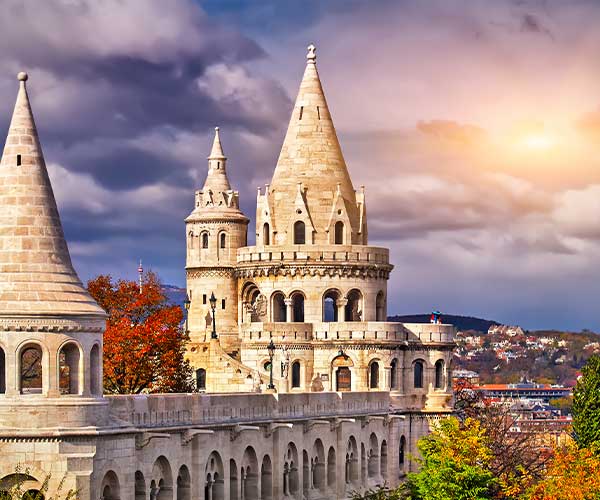 Tallinn Historic Centre, Estonia
The capital of Estonia, Tallinn lies on the coast of the Gulf of Finland and is one of the most popular cities in the Baltic’s. The fairy-tale city quickly transports you to another time, with its charming medieval streets and string of old-age buildings – in fact the city is home to one of the most well preserved Old Towns in Eastern Europe. Since making the list of UNESCO world heritage sites in 1997, Tallinn has flourished into a destination which offers a rich history and modern day flare. The area of the Old Quarter dates back to the 13th century with the majority of the buildings being erected between then and the 16th century. Contained within the ancient city walls is Toompea Hill, St. Olav’s Church and Alexander Nevsky Cathedral. Explore the main square where you’ll find traditional restaurants serving hearty Estonian stews and meats (and local beer!) or wonder up Toompea Hill for the best views over the terracotta rooftops below. Tick off a trip to the Baltic’s by also visiting Riga and Vilnius (capitals of Latvia and Lithuania) which are reached in only a few hours. Both Riga and Vilnius also have UNESCO listed Old Town’s making them fantastic additions for a holiday that dives into the rich history of this corner of the world.
Tallinn Historic Centre, Estonia
The capital of Estonia, Tallinn lies on the coast of the Gulf of Finland and is one of the most popular cities in the Baltic’s. The fairy-tale city quickly transports you to another time, with its charming medieval streets and string of old-age buildings – in fact the city is home to one of the most well preserved Old Towns in Eastern Europe. Since making the list of UNESCO world heritage sites in 1997, Tallinn has flourished into a destination which offers a rich history and modern day flare. The area of the Old Quarter dates back to the 13th century with the majority of the buildings being erected between then and the 16th century. Contained within the ancient city walls is Toompea Hill, St. Olav’s Church and Alexander Nevsky Cathedral. Explore the main square where you’ll find traditional restaurants serving hearty Estonian stews and meats (and local beer!) or wonder up Toompea Hill for the best views over the terracotta rooftops below. Tick off a trip to the Baltic’s by also visiting Riga and Vilnius (capitals of Latvia and Lithuania) which are reached in only a few hours. Both Riga and Vilnius also have UNESCO listed Old Town’s making them fantastic additions for a holiday that dives into the rich history of this corner of the world.
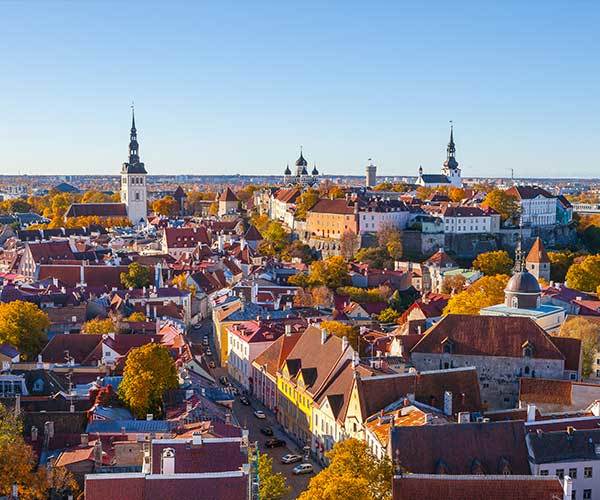 Wooden churches of Maramures, Romania
Widely considered masterpieces of ancient Romanian architecture, these eight wooden churches are situated in the region of Maramures. Maramures, also known as Land of the Wood, is nestled in the very north of Romania. Bursting with tradition and peppered with relics of the country’s rich history, the small area of Maramures is a must see for anyone visiting Romania. Dating back to the 17th century, the wooden churches of Maramures were included in UNESCO’s world heritage list in 1999 because of their traditional timber construction and representation of traditional architecture in the region. Visiting these churches will give you a deeper understanding of where the name The Land of the Wood is derived from, most of the construction was done using wood including nails. The interiors of the churches are just as impressive, with paintings and murals depicting religious events and everyday beliefs.
Wooden churches of Maramures, Romania
Widely considered masterpieces of ancient Romanian architecture, these eight wooden churches are situated in the region of Maramures. Maramures, also known as Land of the Wood, is nestled in the very north of Romania. Bursting with tradition and peppered with relics of the country’s rich history, the small area of Maramures is a must see for anyone visiting Romania. Dating back to the 17th century, the wooden churches of Maramures were included in UNESCO’s world heritage list in 1999 because of their traditional timber construction and representation of traditional architecture in the region. Visiting these churches will give you a deeper understanding of where the name The Land of the Wood is derived from, most of the construction was done using wood including nails. The interiors of the churches are just as impressive, with paintings and murals depicting religious events and everyday beliefs.
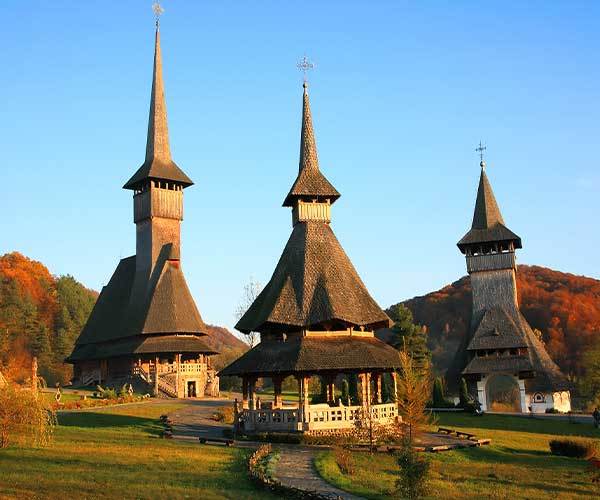 Matt Gannan is the CEO and Owner of Tucan Travel. Tucan Travel operate cultural tours in Latin America, Africa and the Middle East, Asia and Europe, as well as tailor-made holidays in Latin America, Africa and Asia.
If you would like to be a guest blogger on A Luxury Travel Blog in order to raise your profile, please contact us.
Matt Gannan is the CEO and Owner of Tucan Travel. Tucan Travel operate cultural tours in Latin America, Africa and the Middle East, Asia and Europe, as well as tailor-made holidays in Latin America, Africa and Asia.
If you would like to be a guest blogger on A Luxury Travel Blog in order to raise your profile, please contact us.Did you enjoy this article?
Receive similar content direct to your inbox.


Eastern Europe has way more to offer than most people think. The trouble is that so many people still have an image of Eastern Europe as grey and bleak as it was in the bad old days when it languished behind the Iron Curtain. Nice to read a piece singing the places of a part of the world that is often misunderstood.
Thanks for your comment Julian. Eastern Europe has transformed greatly over the recent years and has many beautiful sites. It’s a lot less crowded than Western Europe so I always say visit while you can! :) All the best
One of the great things about Eastern Europe is that it is the east. Over the centuries the Turks and the Russians, as they invaded, brought their architecture with them. And I’m not just thinking of the concrete monstrosities that the Russians built after the end of the Second World War. Budapest is beautiful and surprisingly exotic.
Thanks Elizabeth, you’re right! There exists a lot of fascinating architecture because of that. Skopje, in Macedonia, even has the largest bazaar outside of Turkey. It’s well worth exploring. All the best :)
I just don’t get people at all. You’ve got all of these great places scattered throughout Eastern Europe, scarcely known quiet destinations where you would be as safe as you are going to be from Coronavirus infection. If you went to one of these countries you wouldn’t have to worry about 2 weeks quarantine on your return. But no. Everybody has to crowd the beaches in Greece and Spain. After only two weeks it looks as if Portugal is going to be back on the quarantine list after everybody raced to the beaches there.
Thanks for your comment Sheila. It’s definitely a strange time for travel and I hope that after this people will start to look at quieter, lesser visited places. It will certainly be safer going forward if people spread out a little more and don’t all flock to the same Spanish beaches! All the best :)
UNESCO don’t hand out their recommendations lightly. If a place is on their list it’s definitely worth seeing. When we are researching where to travel I always take a look to see if there’s any sites that get the UNESCO seal of approval.
Thanks for leaving a comment Jeff. I completely agree, a place has to have some kind of significance before UNESCO will recognise it. If you’re on holiday I would always suggest looking up local UNESCO sites, you’ll rarely be disappointed! All the best :)
Nice post. Not sure ‘culmination’ is the right word though. Do you mean ‘combination’? A culmination is a high point reached after putting lots of effort into something.
Thanks for noticing that Carole and you’re right, combination was the correct word. Need to work on my proofing :D All the best
My old neighbour’s daughter went to work in Bulgaria and then she ended up getting married and moving out there. I wouldn’t mind visiting one day for the beauty and the history, but I hadn’t realised that monastery was on the UNESCO world heritage list, I hadn’t even heard of Rila Monastery before now. I’m a sucker for ticking things off lists and trying to see sites like this, really touristy things, so I’ll keep that in mind. I wouldn’t have considered Estonia as a holiday destination before either but again, it’s that history and culture that are really tempting to explore. Great round-up of places and UNESCO sites that don’t often get much recognition.
Thanks for your feedback Marissa and I am glad you got some inspiration from it. Bulgaria is most definitely worth visiting – it has some lovely places and it’s much less crowded than other European countries. Estonia has a charm that’s hard to replicate, Tallinn is simply a scene from a fairytale. All the best :)
Truthfully, I’ve never seen a UNESCO site that I didn’t love. There was a time during the first months of the pandemic that I spent just looking through a list of some of the world’s UNESCO Heritage Sites. I will then go to Google Map and do a street view just to get a view that will seem like I was there. I can tell you I spent hours! I think I was able to virtually visit just 10. And now this list made me want to spend a few more hours again looking around “virtually”.
Hi Geraint, thanks for your comment. Most UNESCO sites are pretty incredible – there is a reason they are listed on UNESCO after all! I love the idea of researching them on Google Maps, we have to find a way to “travel” right now :) All the best
Europe is a dream continent for me but have not thought more thoroughly about Eastern Europe. I read a lot of Eastern European myths and legends most famously, vampires and krampus when I was younger. Seeing these grand castles and old churches that are UNESCO sites in daylight makes a world of difference. They really look straight out of the story books. If I was being honest though, the only one I’d considered to travel to was Moscow Red Square. I also considered Romania because of Vlad the Impaler. It’s quite a fascinating story.
Even though Eastern Europe offers better value for us Brits with our weak pound, I still feel that a lot of my fellow country men and women are still very ignorant of how much it has to offer.
Sadly, the younger generations have embraced Eastern Europe for its cheap beer and firewater shots. Whilst I think a lot of the older generation are still biased by grim grey memories of life behind the iron curtain. Definitely time that we all had a more realistic perception of Eastern Europe and its charms.